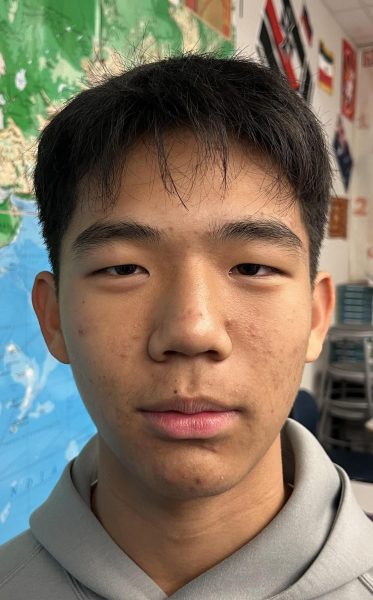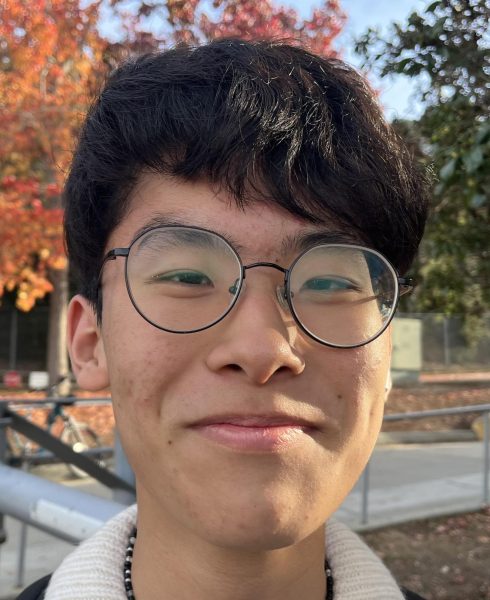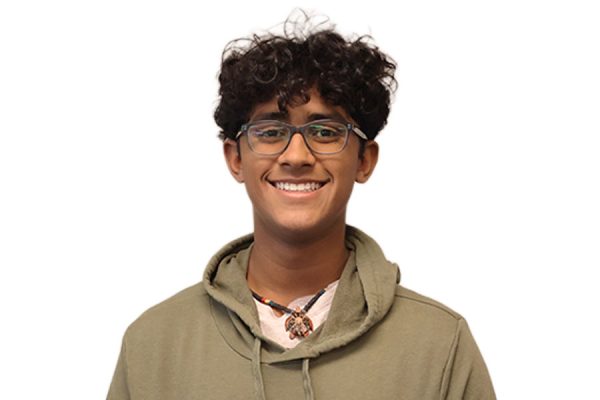Imagine packing your bags and leaving everything you know to go to an entirely different place. You wake up only to have to go to school in a foreign country.
This experience was the case for Carlmont student Maksim Lukoianov. He took the 15-hour flight from St. Petersburg to San Francisco in fifth grade, and his journey was similar to many students going to school in a new country.
“The first day of school was the worst day of my life,” Lukoianov said. “I was introduced to everything for the first time and started crying because I couldn’t speak anything.”
The first day of school was the worst day of my life, I was introduced to everything for the first time and started crying because I couldn’t speak anything.
— Maksim Lukoianov
The student immigrant experience is unique; they must balance two hugely different worlds with different cultures, languages, expectations, and social norms. Often, this split identity creates a weak connection between the student and their two cultures, making them feel like an outsider to both.
Being a student immigrant can also mean being one of the first members of your family to go to school in America. These factors create immense pressure to live up to their parent’s expectations, and many feel that failure might disrespect their parents.
Between the culture split and the pressure to do well academically, student immigrants can feel the effects on their overall mental health, and getting through the day can be a struggle. While the student immigrant experience is often challenging, valuable positives remain. Immigrants can express their pride in their heritage in America and gain a perspective that allows them to be more informed people.
Individual Experiences
Immigration is not a novel idea in the Bay Area, according to the Bay Area Equity Atlas. Over one-third of the population in the nine-county bay area (Alameda, Contra Costa, Marin, Napa, San Francisco, San Mateo, Santa Clara, Solano, and Sonoma) is comprised of immigrants, which is higher than the statewide average.
According to the University of Southern California, San Francisco has always been an inlet to the U.S. for foreign immigrants; in the 1860s, about half of the Bay Area was composed of immigrants. Immigrant history in the Bay Area can be seen everywhere; San Francisco’s Chinatown is the oldest in the U.S., and Jewish immigrants are responsible for many of San Francisco’s libraries and theaters.
Alex Kim is another student immigrant in Carlmont with an interesting immigration story. His parents are Koreans from Argentina and Ecuador. Kim was born in Foster City in 2008, but in 2014, he immigrated to Korea when he was 6-years-old. He stayed there for seven years until he finally moved to Seattle in 2021; he returned to the Bay Area a year later in 2022.
“I think moving around a lot personally helped me,” Kim said.
Kim says he feels he has a better perspective because he met interesting people from many different walks of life. His friends in the Bay Area are much more diverse than his friends in Korea.
Lukoianov and Kim faced many challenges when coming to America, such as making new friends in a different country.
Kim played soccer in America, but getting friends to play in Korea was a struggle because of the air quality.
Moving to Seattle gave Kim cultural shocks in many ways. It took much work for him to shake Korean traditions.
“When I went to Seattle, I would always have to stop myself from bowing,” Kim said. “Seattle was very different than Korea.”
Korea focuses a lot on education for its youth. In Korea, there is a romanticization of overwork. In America, there is more of a focus on creativity and being proactive. Kim quickly realized that America did not reward the silent hard worker, and being a leader was much more important.
“Korea is good because it promotes hard work but can also be hurtful. It does not allow for a lot of self-care,” Kim said.
Kim learned how to excel in school in Korea. However, when he came to America, Kim had to realize that extracurriculars were also important for personal growth. He would meet people of a different background than the typical Korean citizen.
Kim attended a British school in Korea, which allowed his school life to be spoken in English. Later, Kim attended an honors school in Seattle for exceptionally academically driven students. They both promoted fast-paced courses that many students wouldn’t be able to keep up with.
Kim did not have trouble earning good grades in Carlmont’s rigorous school life. However, he did have trouble finding new friends in a place where friend groups from Ralston and Terra Linda carried over.

I don’t think that schools are doing enough to help immigrants, but I also recognize that students must embrace the places they go to.
— Alex Kim
Coming to a new place without knowing anyone seems insurmountable, but Kim mainly finds friends through extracurricular activities. As a freshman, he fostered many friends through soccer clubs and clubs at school, like the Distributive Education Clubs of America (DECA).
“I don’t think that schools are doing enough to help immigrants, but I also recognize that students must embrace the places they go to,” Kim said.
Kim understands that many immigrants have trouble fitting into new school systems and different societal norms. His advice to immigrants is not to look back and try to immerse themselves in the places they go.
It can be hard to understand American culture, especially when you can’t speak English. Many children have difficulty adapting to new places; they often feel lost in the American environment.
Jiho Park, a sophomore at Carlmont, is a first-generation immigrant. When Park was eight years old, he moved to the Bay Area from Korea. These changes were complex for a young child who barely knew any English.
“I would hang out with other international students who struggled with English,” Park said.
As a child, it was hard for him to befriend other American students; other non-American students felt the most familiar with Park.
Like many other immigrants at Carlmont, Park views his life in America as better than back in his home country.
Park notes that he never felt any racism other than when he would occasionally mix up his English. Many people in the Bay Area are very different and have learned to accept each other.
“I like America, I don’t think I’d be who I am if I never immigrated,” Park said.

I like America, I don’t think I’d be who I am if I never immigrated.
— Jiho Park
While the experience is not entirely the same, second-generation students face similar struggles and their own unique challenges.
Like most student immigrants, they are often pressured to do well in school.
“My parents want the best for my future, so I constantly feel like I have to perform well for them,” said sophomore Ashlynn Son.
Son is a Korean-American born in San Diego. Her parents were born in Korea and moved to America after completing college. She stays connected with her roots by speaking Korean at home and attending a Korean Church.
Other second-generation students share this sentiment, with scrutinizing performance as a common theme.
“Every day, my dad and mom ask about my homework, tests, and grades, and they always question me when one of my grades goes down,” said sophomore Avi Dhamija.
Dhamija is an Indian-American born in Redwood City, and his parents are both immigrants from Asia. Dhamija is a practicing Sikh and spends his time going to Gurudwara and practicing religious traditions. Religion is an important way for immigrants to stay connected to their culture.
Second-generation students also must balance two cultures, often with one coming at the expense of the other.
“When I was younger, I would feel disconnected from my American classmates because they ate different foods at lunch, and they would talk about American shows that I didn’t watch,” Son said. “Now I feel much more connected to my American classmates because I had such a desire to fit in with my peers when I was young.”
How Immigrants Adjust
Cultural clubs, such as the Latino, French, Indian, Filipino, and Japanese Culture Clubs, play a role in facilitating relationships between students of the same culture and, on the whole, educating Carlmont students about different customs and heritage.
“Carlmont is obviously multiracial and multicultural. I feel like culture clubs help students connect with their heritage,” said Yunosuke Nakamura, the president of Carlmont’s Japanese Culture Club.
Several members of Nakamura’s club are part of Carlmont’s English Language Learner program. The club serves as a bridge between their own culture and their new school.
“We try to get them into a community by presenting a culture similar to what they know,” Nakamura said. “We introduce them to other students and get them familiar with culture here.”
Counselors play a significant role in connecting student immigrants with cultural ambassadors like Nakamura.
Mathew Ledesma has been a counselor at Carlmont for over five years and does many things, including helping immigrants adjust to Carlmont.
“I try to give the students something that they can hold on to. I usually figure this out by talking to them.” Ledesma said. “It can be hard if we don’t know their language, but I try to use Google Translate or whatever I can to talk to the student at the moment.”
Carlmont counselors work to help first-generation students achieve their goals. These goals range from getting into a four-year college to a high school diploma. The student’s goals are often based on their background or their parent’s level of education.
Student immigrants usually need help navigating the American school system. The counselor’s job is to help student immigrants overcome this particular period of their lives.
“They may not be aware of the cost to attend schools or the types of education provided in America,” Ledesma said.
Carlmont takes an approach called Comprehensive Counseling. This approach helps students understand how they can graduate. These lessons are tailored to each student’s grade level. All Carlmont students get exposed to lessons about how to graduate from high school. Freshmen at Carlmont are given many opportunities to learn about the A-G requirements.
“We also have after-school help sessions and parent information nights,” Ledesma said. Some immigrant parents do not understand the American school system, and these nights allow them to understand better how to help their child succeed in school.
Some students know broken English, while others need to learn the language altogether. The language barrier is a massive challenge for them, and it is up to counselors like Ledesma to make sure they get the support they need.
With the conjunction of counselors, Carlmont supports English learners through the English Learning Advisory Committee (ELAC). This acts as a bridge between students and the school system. Committees like this are essential to helping first-generation students succeed at Carlmont.
“When our students come here, they can feel very anxious and nervous,” Ledesma said. “I think that if we provided more counselors that could target specific students, then it may help immigrants get better support.”
Counselors at Carlmont must manage numerous students, so it is difficult for them to give specific support to students.
Life after immigration
Entering his sixth year in an American school, Lukoianov has found that his experience has changed dramatically.
“It was a struggle, but over time, I just got used to it. The teachers were very helpful, and everyone in class was very inclusive and kind, so it helped me a lot,” Lukoianov said.
While going to school in a new country is a big adjustment, the journey becomes easier with time and a good community.
“I think being a student immigrant can be really good, but you have to put yourself out there to succeed,” Kim said. “If you’re open-minded and embrace the new opportunity, I think it’s a beneficial experience.”
The experience of a student immigrant is unlike any other. Cultural differences, language barriers, outside pressures, and educational adjustment are all hurdles they must overcome. These students have found ways to push through and succeed socially and academically, giving them a unique outlook on life.
“Being a student immigrant has shaped who I am,” Kim said. “My perspectives aren’t confined to just one culture, and I’m able to see it through multiple points of view.














